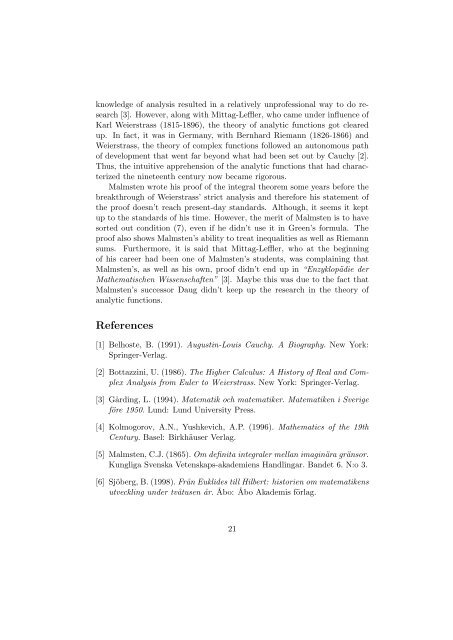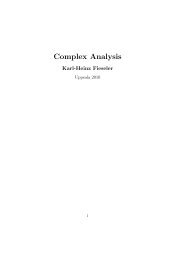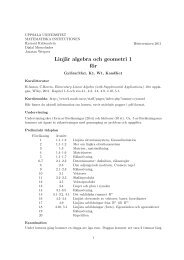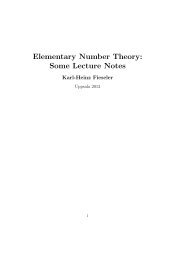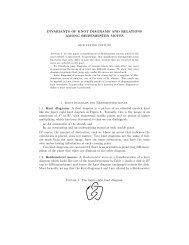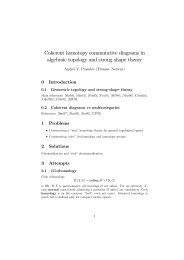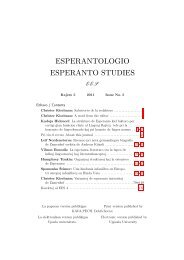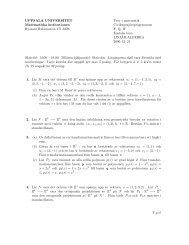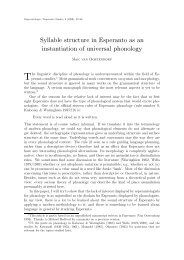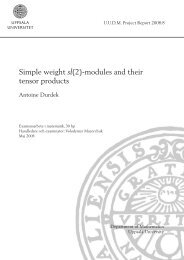Malmsten's Proof of the Integral Theorem
Malmsten's Proof of the Integral Theorem
Malmsten's Proof of the Integral Theorem
- No tags were found...
You also want an ePaper? Increase the reach of your titles
YUMPU automatically turns print PDFs into web optimized ePapers that Google loves.
knowledge <strong>of</strong> analysis resulted in a relatively unpr<strong>of</strong>essional way to do research[3]. However, along with Mittag-Leffler, who came under influence <strong>of</strong>Karl Weierstrass (1815-1896), <strong>the</strong> <strong>the</strong>ory <strong>of</strong> analytic functions got clearedup. In fact, it was in Germany, with Bernhard Riemann (1826-1866) andWeierstrass, <strong>the</strong> <strong>the</strong>ory <strong>of</strong> complex functions followed an autonomous path<strong>of</strong> development that went far beyond what had been set out by Cauchy [2].Thus, <strong>the</strong> intuitive apprehension <strong>of</strong> <strong>the</strong> analytic functions that had characterized<strong>the</strong> nineteenth century now became rigorous.Malmsten wrote his pro<strong>of</strong> <strong>of</strong> <strong>the</strong> integral <strong>the</strong>orem some years before <strong>the</strong>breakthrough <strong>of</strong> Weierstrass’ strict analysis and <strong>the</strong>refore his statement <strong>of</strong><strong>the</strong> pro<strong>of</strong> doesn’t reach present-day standards. Although, it seems it keptup to <strong>the</strong> standards <strong>of</strong> his time. However, <strong>the</strong> merit <strong>of</strong> Malmsten is to havesorted out condition (7), even if he didn’t use it in Green’s formula. Thepro<strong>of</strong> also shows Malmsten’s ability to treat inequalities as well as Riemannsums. Fur<strong>the</strong>rmore, it is said that Mittag-Leffler, who at <strong>the</strong> beginning<strong>of</strong> his career had been one <strong>of</strong> Malmsten’s students, was complaining thatMalmsten’s, as well as his own, pro<strong>of</strong> didn’t end up in “Enzyklopädie derMa<strong>the</strong>matischen Wissenschaften” [3]. Maybe this was due to <strong>the</strong> fact thatMalmsten’s successor Daug didn’t keep up <strong>the</strong> research in <strong>the</strong> <strong>the</strong>ory <strong>of</strong>analytic functions.References[1] Belhoste, B. (1991). Augustin-Louis Cauchy. A Biography. New York:Springer-Verlag.[2] Bottazzini, U. (1986). The Higher Calculus: A History <strong>of</strong> Real and ComplexAnalysis from Euler to Weierstrass. New York: Springer-Verlag.[3] Gårding, L. (1994). Matematik och matematiker. Matematiken i Sverigeföre 1950. Lund: Lund University Press.[4] Kolmogorov, A.N., Yushkevich, A.P. (1996). Ma<strong>the</strong>matics <strong>of</strong> <strong>the</strong> 19thCentury. Basel: Birkhäuser Verlag.[5] Malmsten, C.J. (1865). Om definita integraler mellan imaginära gränsor.Kungliga Svenska Vetenskaps-akademiens Handlingar. Bandet 6. N:o 3.[6] Sjöberg, B. (1998). Från Euklides till Hilbert: historien om matematikensutveckling under tvåtusen år. Åbo: Åbo Akademis förlag.21


